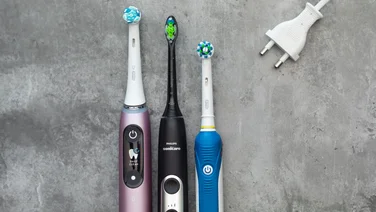To help us provide you with free impartial advice, we may earn a commission if you buy through links on our site. Learn more

Receding gums can be a big problem for your oral health. It’s actually a form of gum disease and can range from mild to severe: as gum tissue is pulled away from the tooth’s surface, the sensitive root beneath is exposed to increased bacteria and potential damage.
Your gums can start receding at any age. Although more likely to happen in the over 60s, more than half the population can experience it during adulthood – almost a fifth of adults in the UK have been told they have gum disease by a dental health professional.
So how do you prevent receding gums from happening? We spoke to Dr Alexandra Day at Chelsea & Fulham Dentist about protecting your gums, and what to do if your gums recede.
READ NEXT: Best electric toothbrushes
What’s the cause of receding gums?
While there can be a number of reasons that your gums may recede, it’s typically due to poor oral hygiene – and plaque is the main culprit. That sticky substance caused by bacteria has to be removed using a fluoride toothpaste, particularly before you sleep, since plaque can easily calcify overnight, turning to tartar. At that point, normal brushing won’t cut it – a dentist or hygienist will have to remove this buildup for you, or you risk receding gums.Most of the time, your gums recede because you’re brushing your teeth too hard, brushing too often or brushing them incorrectly. “Though toothbrushes provide an excellent clean, they can often be too hard on the gums,” said Dr Day. “This can cause unwanted gum recession, where the gum is pushed away from the tooth exposing the underlying root.” An improper brushing technique can cause low-level trauma to the gums, and over a long period of time this can cause recession.
There are broader influences that can result in receding gums, too. These can include:
- Poor diet: Eating lots of sugar allows more bacteria to thrive and irritate your gums.
- Smoking or vaping: Nicotine is well known for its negative effects on oral health; it reduces blood flow to the gums and can eventually kill off gum tissue.
- Genetics: Some people are genetically disposed to receding gums, and have family histories of periodontal disease.
- Stress and anxiety: Bruxism – the act of grinding your teeth or clenching your jaw, most often at night – is typically caused by stress. Bruxism puts constant pressure on the gums, damaging soft tissue and affecting tooth mobility.
READ NEXT: Best Oral-B toothbrushes
How can you tell if your gums have receded?
Gums will recede pretty slowly, so it isn’t so easy to become aware of it in the early stages.
The first step is to have a good look at your gum tissue. Usually your gums are at the same height on each tooth, and are a consistently pink colour. However, if your gums are receding then it may sit at differing heights from tooth to tooth, and the colour might be more red than usual.
Of course, you may already be aware of an issue with your gums. Early symptoms include bad breath, swollen or bleeding gums and sensitive teeth. Feeling that your teeth are loosening is a more serious symptom of gum recession; this indicates your gums are too damaged to hold teeth in place.
Is it dangerous for your gums to recede?
If your gums recede too far, the tissue pulls away from your teeth and pockets of space form between gum and tooth, becoming a breeding ground for bacteria. At this point, inflammation and deep infections can easily develop, and there’s a high risk of tooth decay or tooth loss.
Gingivitis is the early, inflamed stage of gum disease. If caught and treated quickly enough, it’s a reversible condition. The signs of gingivitis include swollen and bleeding gums and a general sense of inflammation.
Periodontitis is a serious gum infection, causing severely receding gums and deep pockets between teeth. It happens when gingivitis is left untreated, and when the inflammation has become destructive. Without treatment, the bone that supports your teeth can be destroyed. The damage caused by periodontitis on teeth and gums is irreversible.
READ NEXT: Best water flossers
How do you stop receding gums?
Unfortunately, you can’t cure receding gums – but various treatments can stop the recession in its tracks, ensuring it doesn’t get any worse. Alongside treatment from a professional dentist (which is highly advised), there are plenty of things you can do at-home to tackle the issue.

If you’re actively suffering with receding gums, you can do the following:
- Brush your teeth gently and slowly, being mindful of the amount of force you’re applying (only a gentle pressure is needed).
- Switch up your brushing technique: opt for circular strokes rather than the typical up and down.
- Use a softer bristled brush than usual.
- Use a toothpaste that’s been designed for sensitivity or for gums.
- Avoid extreme temperatures in food – no ice or hot drinks.
- Avoid sugar as much as possible.
Staying on top of your gum health is really important, as it helps to maintain good oral hygiene in the long run. That means flossing daily, brushing your teeth twice a day and avoiding hard-bristled toothbrushes if you’re a naturally aggressive brusher. Aim to lightly brush your gums to remove plaque from the gumline, and brush each tooth gently in a circular motion rather than a horizontal back-and-forth. It’s best to a use both a toothpaste and mouthwash that contain fluoride, and spit after brushing – don’t rinse.
It’s also a good idea to eat healthily, maintain a balanced diet with plenty of water, avoid smoking or vaping, and try to see your dentist regularly every six months or so.






